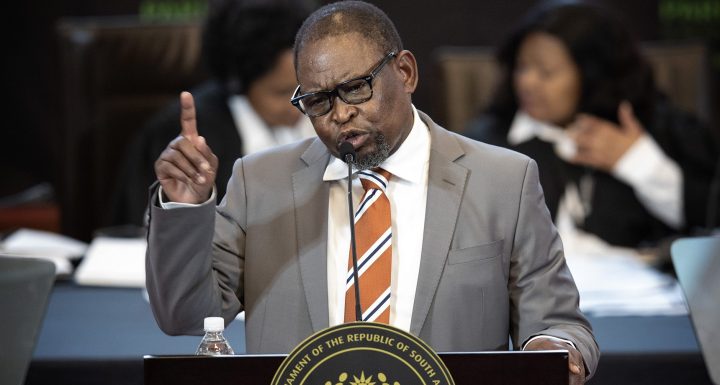MTBPS OP-ED
SA’s mini budget rewarded for fiscal restraint in the face of a growth imperative

Structural change, laying a foundation for stronger growth and crowding in the private sector were some of the watchwords in a well-received budget that resisted the temptation to use the might of the fiscus to actively boost the economy. Downside risks prevail, though, requiring the strong and capable state the Finance Minister mentioned in his speech.
South Africa’s mini budget and the recent UK fiscal debacle have one thing in common: their single-minded emphasis on growth and what government can do to lift it in the years ahead.
Just how focused the government is on growth is reflected in the number of times Finance Minister Enoch Godongwana mentioned growth in his Medium-Term Budget Policy Statement (MTBPS): 25 times, more than double the 11 times in his February Budget speech.
Two of these referred to the global growth risks that surround us, and one to the impact of declining Chinese growth on global demand and supply chains.
But the rest reinforce the singular fact that South Africa’s expected growth rate over the next few years – around 2% – is too low to support the government’s development goals.
“Accordingly, we must take action to put our economy on a higher growth trajectory,” Gondongwana said in his speech.
Former British prime minister Liz Truss’ desire to rally growth by cutting tax rates and threatening to leave a 45-billion pound hole in the UK budget set the country on a tumultuous path that saw the market for 30-year gilts dry up, 10-year gilt yields soar to almost 4.5%, and the pound in the ignominious position of almost reaching parity with the dollar.
Most worrying because it could have global repercussions, was that the financial market ructions almost brought UK defined benefit pension funds to their knees.
In contrast, this week’s South African mini budget was predominantly even-keeled, delivering on the National Treasury’s promise to achieve fiscal consolidation over the three-year period of the medium-term budget framework.
The government also resisted the temptation to loosen the reins and spur growth with a series of expansive fiscal measures. It’s a temptation that some other governments are giving in to, with Oxford Economics analysis on policy shifts finding that “fiscal policy has begun to play a more active part in business cycle management, having being held on the sidelines for a time”.
In the 2010s, fiscal policy was used successfully to manage economies, but at that time the economic landscape was very different, with no space for conventional monetary policy to contribute to economic growth, space capacity in the economy and excess savings, according to the research house.
But, says Oxford Economics Director of Global Macro Research Ben May, “when supply shocks dominate and inflation pressures are greater, more active fiscal policy makes it harder for central banks to meet their mandate”.
Visit Daily Maverick’s home page for more news, analysis and investigations
Were fiscal and monetary policy to conflict, we could expect higher government debt, higher interest rates and rising inflation – a cost the global economy couldn’t bear when it is already at such a low ebb.
May says although the recent market reaction to the UK’s mini budget may temper enthusiasm for pursuing expansive fiscal measures if governments did try to manage demand, even greater volatility in inflation, policy rates, and economic growth would ensue.
Fortunately, it doesn’t look like it’s a risk National Treasury is willing to take, with the mini budget spelling out a positive fiscal outlook in which it will achieve a primary fiscal surplus of 0.7% of GDP by 2023/24 – one year earlier than projected at the 2021 MTBPS – and stabilise gross government debt at 71.4% of GDP in 2022/23 – two years earlier, and at a lower level, than projected in the 2022 Budget Review.
These potential achievements have been made possible by a combination of hard work, a favourable tax revenue-generating environment and high inflation bolstering nominal growth forecasts.
The latter two are, of course, subject to considerable risk because South Africa is so susceptible to changing global economic fortunes, but most promising is the National Treasury’s conviction and determination to make the structural changes to the South African economy that are needed to shift the growth rate upwards to a more sustainable level.
Key to getting there are the infrastructural investment drive – a potentially hugely positive growth enabler that is entirely achievable – and getting state-owned enterprises on a sustainable footing, a tough, still potentially insurmountable challenge.
The latter requires a huge leap of faith, notwithstanding the significant sums designated to resurrecting Denel, Transnet and Sanral, and the government taking on one- to two-thirds of Eskom’s debt.
Also, some market participants don’t share the same enthusiasm regarding the government taking Eskom’s debt onto its own balance sheet because, they say, implicitly, it has been happening all along, given that most of Eskom’s debt is government guaranteed.
One positive, though, is that the government is unlikely to give Eskom any more equity injections.
The government’s intentions are good, recognising the critical role SOEs play in the economy and the drag they are imposing on the local economy at present.
Godongwana captures this sentiment when he says, “These companies should be self-sufficient and must contribute to economic growth. The financial support to SOEs recognises their potential to contribute to our long-run growth prospects.”
The financial markets’ response to the South African mini budget was a pleasure compared to the whipping Liz Truss took for announcing her fiscal package a few weeks ago.
One investment manager described the budget as “unambiguously positively received”.
The rand strengthened to below R18 to the dollar from R18.15 in the morning. Bonds rallied 50 basis points across the yield curve, with the long end up 2% on the day – the All Share Index also rose almost 2%.
However, if the past four years have taught us anything, it’s to expect the unexpected.
The government’s finances have benefitted from several tailwinds this year, but the National Treasury will need to be at the ready to manage the many downside risks that still haunt the world in general and South Africa in particular if it wants to deliver on the venerable goals spelt out in the mini budget. BM/DM


















 Become an Insider
Become an Insider
Comments - Please login in order to comment.